TRIX indicator is an abbreviation of ‘TRIple eXponential’ as it is based on triple smoothed exponential moving average. It was developed by Jack Hutson, an editor for Technical Analysis of Stocks and Commodities magazine, in the early 1980’s. In fact, TRIX indicator is an oscillator (it oscillated around its centerline) that combines trend (moving averages are trend-following indicator) with its momentum. The main idea that stands behind TRIX is to filter price noise and insignificant price moves, so technical analysts can better see the trend and how much it dominates.
The formula for TRIX indicator looks like follows.
Choose the "x" value first. It is the time period for the indicator calculation.
EMA1 = EMAx of Close
EMA2 = EMAx of EMA1
EMA3 = EMAx of EMA2
TRIX = (EMA3 n – EMA3 n-1) / (EMA3 n-1)
(Note: EMA3 n = Today's EMA3; EMA3 n-1 = Yesterday's EMA3)
If we decide to calculate 11-day TRIX we calculate 11-day EMA of Close prices first (so far we have single-smoothed EMA). Then we calculate 11-day EMA of the single-smoothed EMA (we get double-smoothed EMA). Finally we calculate 11-day EMA of the double-smoothed EMA (and so we get triple smoothed EMA). To simplify that, we have just calculated 11-day EMA of 11-day EMA of 11-day EMA.
The picture below shows the difference among the moving averages. The white curve stands for Simple smoothed 11-day EMA, the yellow curve stands for Double smoothed 11-day EMA and the blue curve stands for Triple smoothed 11-day EMA. The very TRIX index is shown in the chart below the picture.
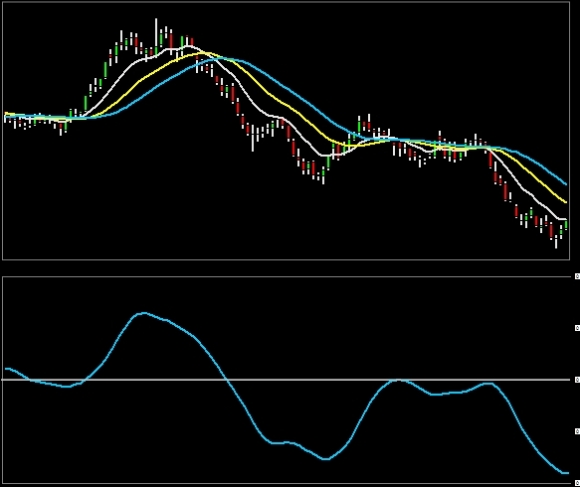
As you can see with every next smoothing we get smoother curve of a moving average, but it is also more lagging. That is because the moving average itself is a lagging indicator (it generates signals later but on the other side the more reliable they should be). The smoothing ensures that the small up and down price swings are kept to minimum and a technical analyst can see the trend clearer. Not every little pullback means a trade should be exited or that the trend is about to reverse. If an analyst wants to make it more sensitive to price changes he can use shorter period for TRIX calculation. That would also make the indicator being more volatile.
TRIX values are positive as long as the triple smoothed EMA moves up. Once it turns down, the values become negative.
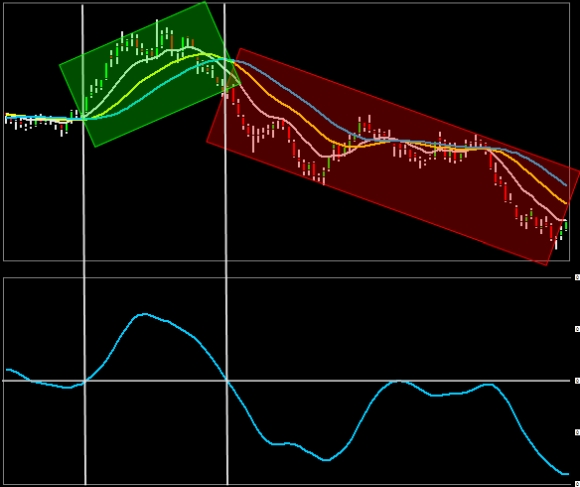
The values are not bound by any upper or lower limits. The technical indicator just illustrates how much has the Triple smoothed EMA changed from yesterday in %. Should yesterday’s triple smoothed EMA be 50 units and today’s 51 units than TRIX would equal to +2 % (triple smoothed EMA has risen by +2 % from yesterday). Should yesterday’s triple smoothed EMA be 50 units and today’s 49 units than TRIX would equal to -2 % (triple smoothed EMA has fallen by -2 % from yesterday). Now we know that TRIX is a 1-day Rate of change of Triple smoothed EMA. The higher the absolute percentage is (either positive or negative percentage) the stronger the momentum is. Decreasing percentage (approaching the zero-line) would mean that indicator and dominant market trend are loosing their momentum.
TRIX is sometimes being compared to MACD but while MACD displays the differences between short and long term moving averages of a price, TRIX is several times applied moving average to a series of data. The thing they have in common is that they both can use 9-day moving average as the signal line. TRIX is also sometimes being compared to Percentage price oscillator (PPO) but it also uses one short term and one long term EMA for its calculation.
In the picture below we would like to show you the difference between MACD and TRIX. The violet curve stands for the MACD (set to 16 and 22 days) while the blue curve stands for TRIX (set to 11 days). The days have been chosen deliberately to get as similar curves as possible. As you can see, the TRIX produces even smoother curve than MACD does but it is also a bit more lagging.
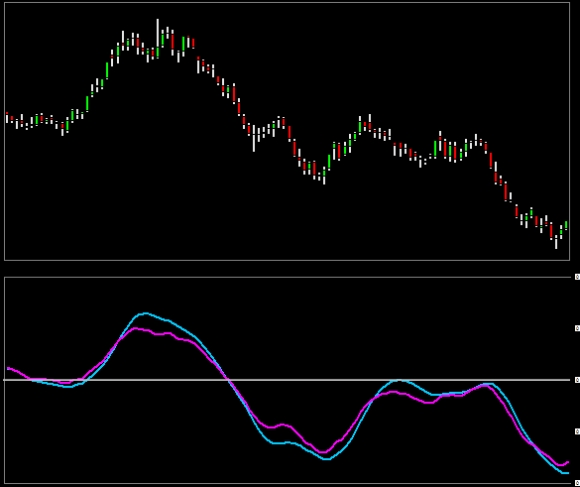
How to use TRIX indicator for technical trading?
There are many strategies. First of all - the best way how to comprehend them, is to imagine the TRIX area above zero-line as an UP trend and the area below zero-line as a DOWN trend. Moreover, TRIX curve shows us the trend momentum so moving away from the zero-line means acceleration while heading towards it means deceleration of the previous trend.
• One of the basic strategies is that when TRIX rises above its zero-line, we go Long. When it falls below the zero-line, we go Short. The rise above the zero-line (baseline or centerline) means that Triple smoothed EMA has just changed its direction from down to up. This signal should now be strong enough to go with the UP trend and enter just Long positions. And this is also true vice versa (the fall below zero-line would mean dominant DOWN trend).
• We go Long when TRIX rises above its signal line (e.g. 9-day EMA of TRIX values). We go Short when TRIX falls below its signal line. This technique is focused more on the momentum of the actual trend and traders do get the entry end exit signals sooner than by waiting for crossing the zero-line. Crossing the Signal line down means that bullish momentum is weakening and maybe there is a time to sell the asset. Crossing the Signal line up means that bearish momentum is weakening and there is a time to buy. The signal line is typically of shorter length than the number of periods used in the TRIX calculation. By using this trading strategy the analysts are getting closer to using the index as a counter-trend oscillator (like RSI, CCI or Stochastic) but they should also use shorter periods to get the buy and sell signals sooner (please take into account that the trend can persist for a very long time even on weakening momentum).
• Next strategy is to trade the bullish and bearish divergences. They can alert us of a possible trend reversal. Bullish (or positive) divergences are created when the price chart makes lower lows but TRIX chart creates higher lows. This could signalize a time to buy. Bearish (or negative) divergences are when price chart creates higher highs but TRIX curve does not (a proper time to sell the asset). We can also search for other chart patterns (trend lines, supports etc.). The chart patterns have the same effect on the TRIX as they would have on standard price chart.
The picture below shows 11-day TRIX (blue) and its 3-day moving average as the Signal line (violet). Their difference is displayed by the histogram (white bars).
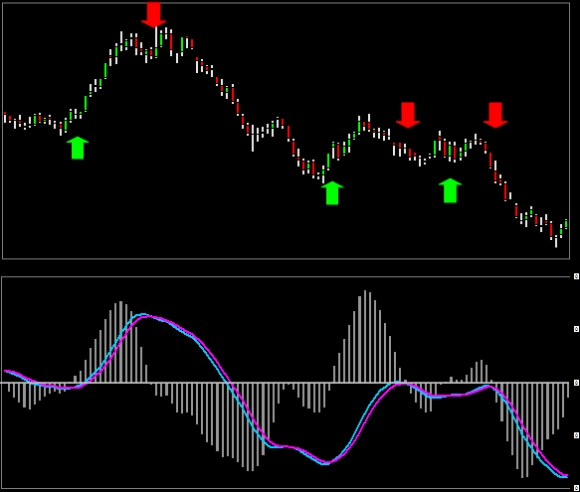
As you can see, the difference between TRIX and its Signal line produces sooner signals than the zero-line crossing would. You might also noticed that TRIX works really well in trending market (left side of the chart) but does not do so well in ranging market (right side of the graph).
Sometimes the TRIX index is considered being also a leading indicator. We decided to set one of the leading indicators (Stochastic) as similar to TRIX as possible. You can see the result in the picture below (The blue curve stands for TRIX; Stochastic is displayed by the violet curve).
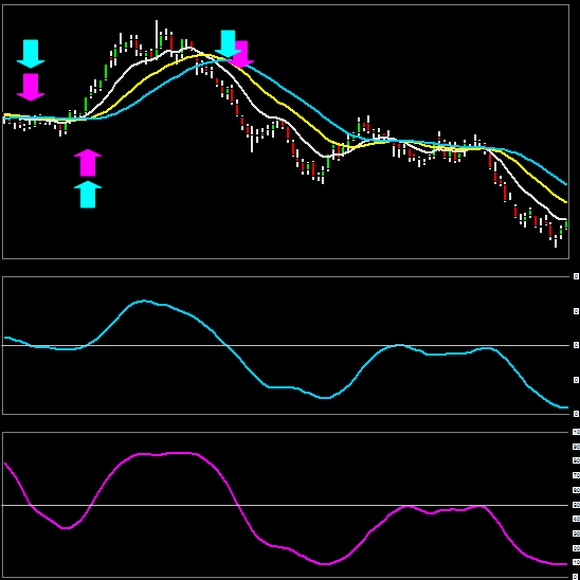
As you can see, TRIX can really react faster than Stochastic (have a look at the arrows). On the other side, Stochastic has to be set to very long periods to get a curve so similar to TRIX (in this case calculated on 30-days period, 7-day smoothing for fast stochastic and 7-day smoothing for slow stochastic). Moreover, Stochastic signals are usually generated by 80/20 levels (not by the 50 base-line) so we would get the signals a bit sooner.
Despite its ability to filter out the market noise, we would recommend you to combine TRIX index with other indicators and signals that can help you to improve trading performance. As with all of the technical indicators the best thing every trader can do is to test his own data, his own settings, and his own rules how to trade. Surprisingly, sometimes the best result can be achieved with unusual settings and trading rules that are quite strange at a first glance – the more things a trader can change and experiment with the better for him and his trading strategy.
If you are interested in a deeper study of this technical indicator and prefer ready to serve solutions, this section may be of interest to you. There you can find all available indicators in Excel files for download
